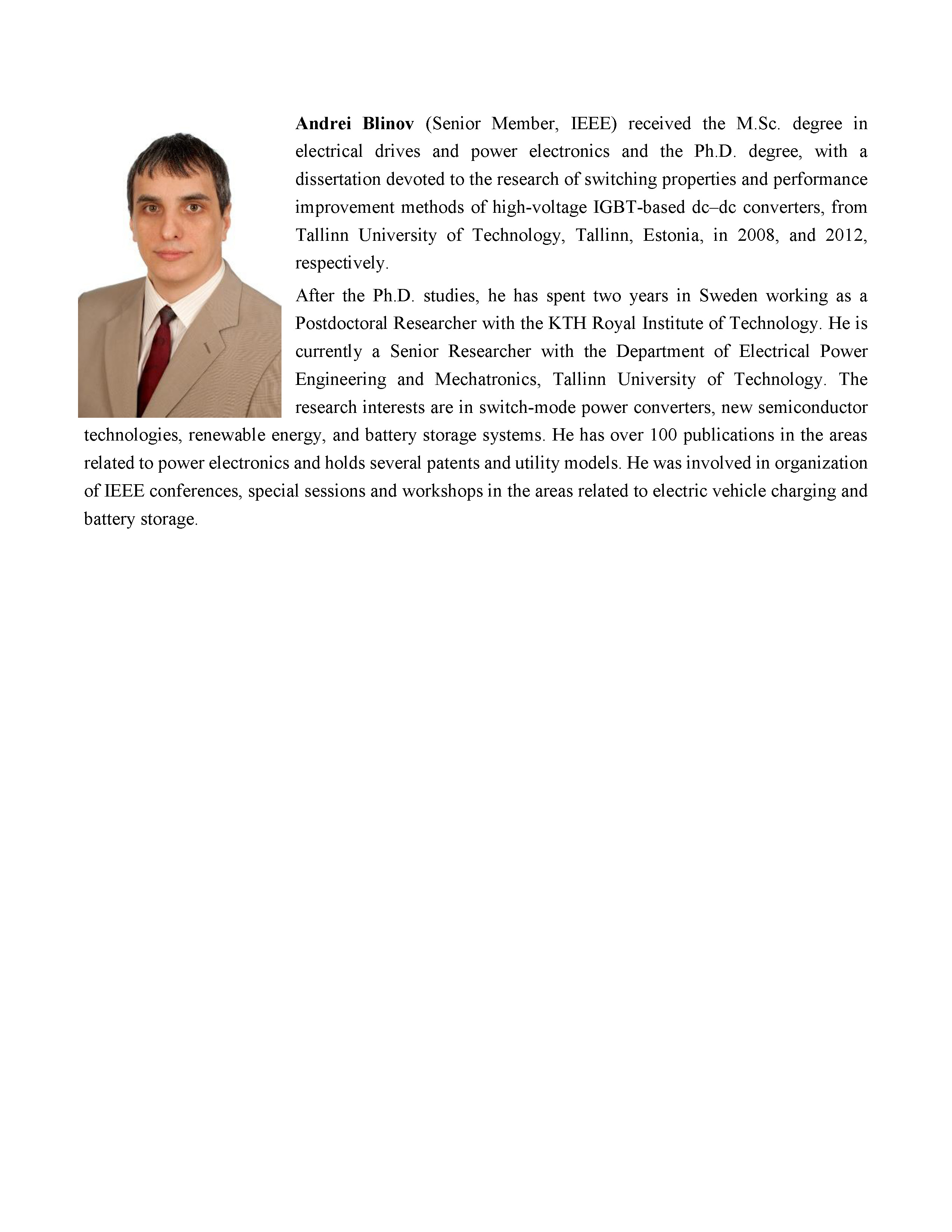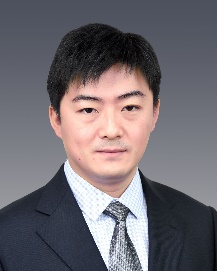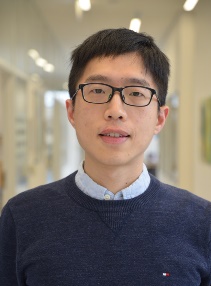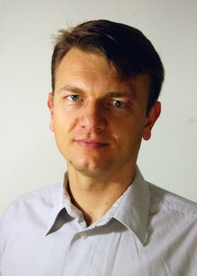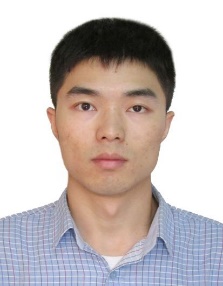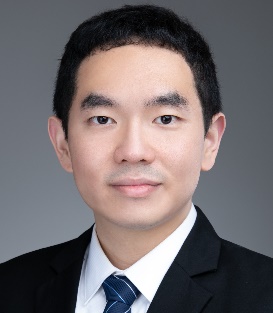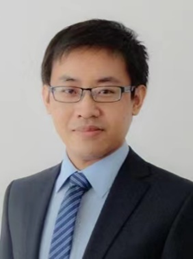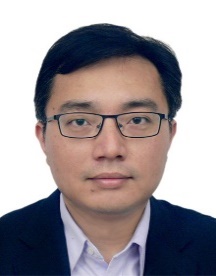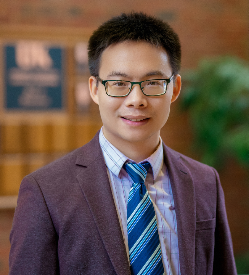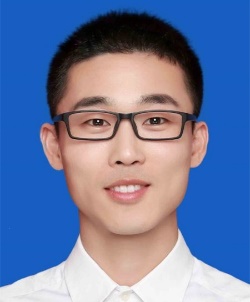Tutorial

1.
Modeling and Control of Grid-Tied Converters for Distributed Energy Resources

|
Speaker(1) |
Name |
Jingyang Fang |
|
|
Title |
Full Professor |
||
|
Affiliation |
Shandong University |
||
|
|
jingyangfang@sdu.edu.cn | ||
|
Speaker(2) |
Name |
Hao Tian |
|
|
Title |
Full Professor |
||
|
Affiliation |
Shandong University |
||
|
|
haotian@email.sdu.edu.cn |
||
|
Speaker(3) |
Name |
Tao Xu |
|
|
Title |
Associate Professor |
||
|
Affiliation |
Shandong University |
||
|
|
txu@sdu.edu.cn |
||
|
Speaker(4) |
Name |
Feng Gao |
|
|
Title |
Full Professor |
||
|
Affiliation |
Shandong University |
||
|
|
fgao@sdu.edu.cn |
|
Abstract |
Distributed energy resources, such as solar photovoltaics (PV) and wind, generally penetrate into modern power grids via grid-tied converters, which determine the active/reactive power injection and current/voltage quality, thereby making themselves the enabler of distributed energy sources. However, the large-scale deployment of grid-tied converters challenges the secure and reliable operation of modern power grids in terms of stability and power quality at both converter and system levels. Typical challenges include the loss of inertia and damping, reduced grid strength, and over-current problem as well as excessive circulating currents, current/voltage harmonics, synchronization, etc. To overcome such challenges, accurate modeling and advanced control of individual and multiple grid-tied converters are expected. To this end, the tutorial will comprise the following aspects: modeling and control of grid-forming converters, advanced multilevel converters with novel topologies and grid-supportive services, and multiple grid-tied converters with self-synchronized carrier waves. The tutorial targets at stability analysis and improvement, delivery of grid-supportive services, high-efficient and low-cost power converter design, synchronization without dedicated communication cables, switching harmonic suppression, and circulating current attenuation of grid-tied converters for distributed energy sources. In particular, the tutorial will cover some state-of-the-art industrial products and their design experience. |
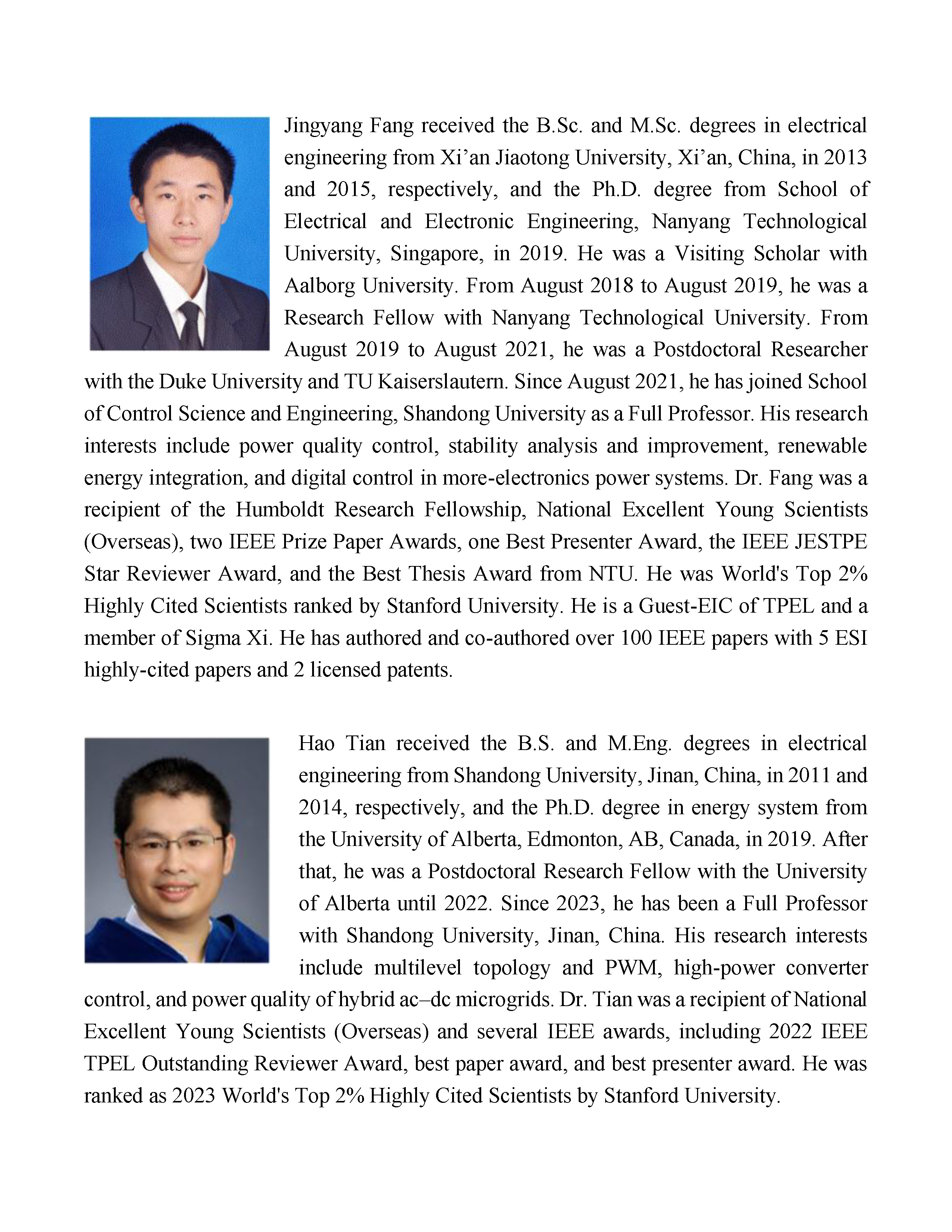

2.
Model Predictive Control: Basic concepts, Applications, Advances and Trends

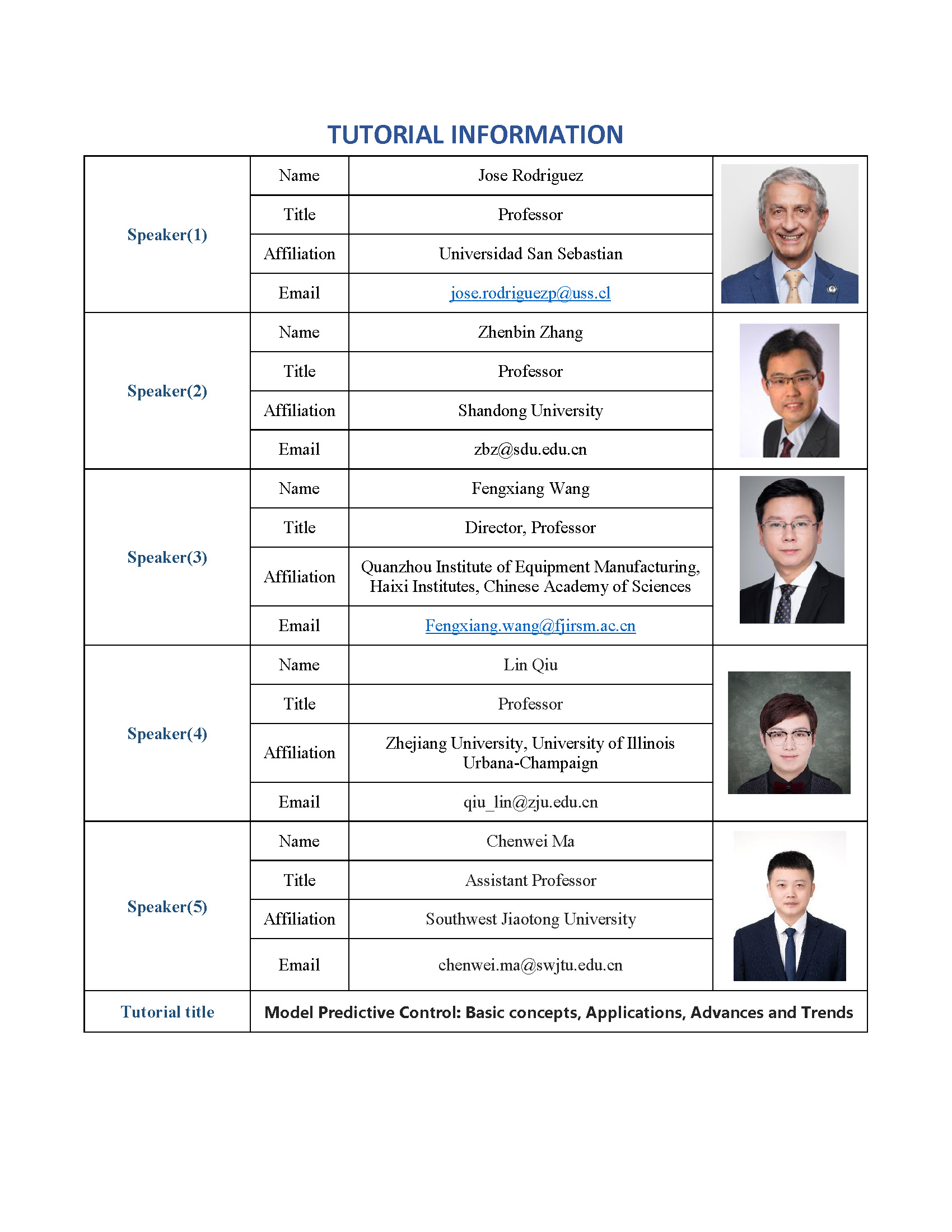

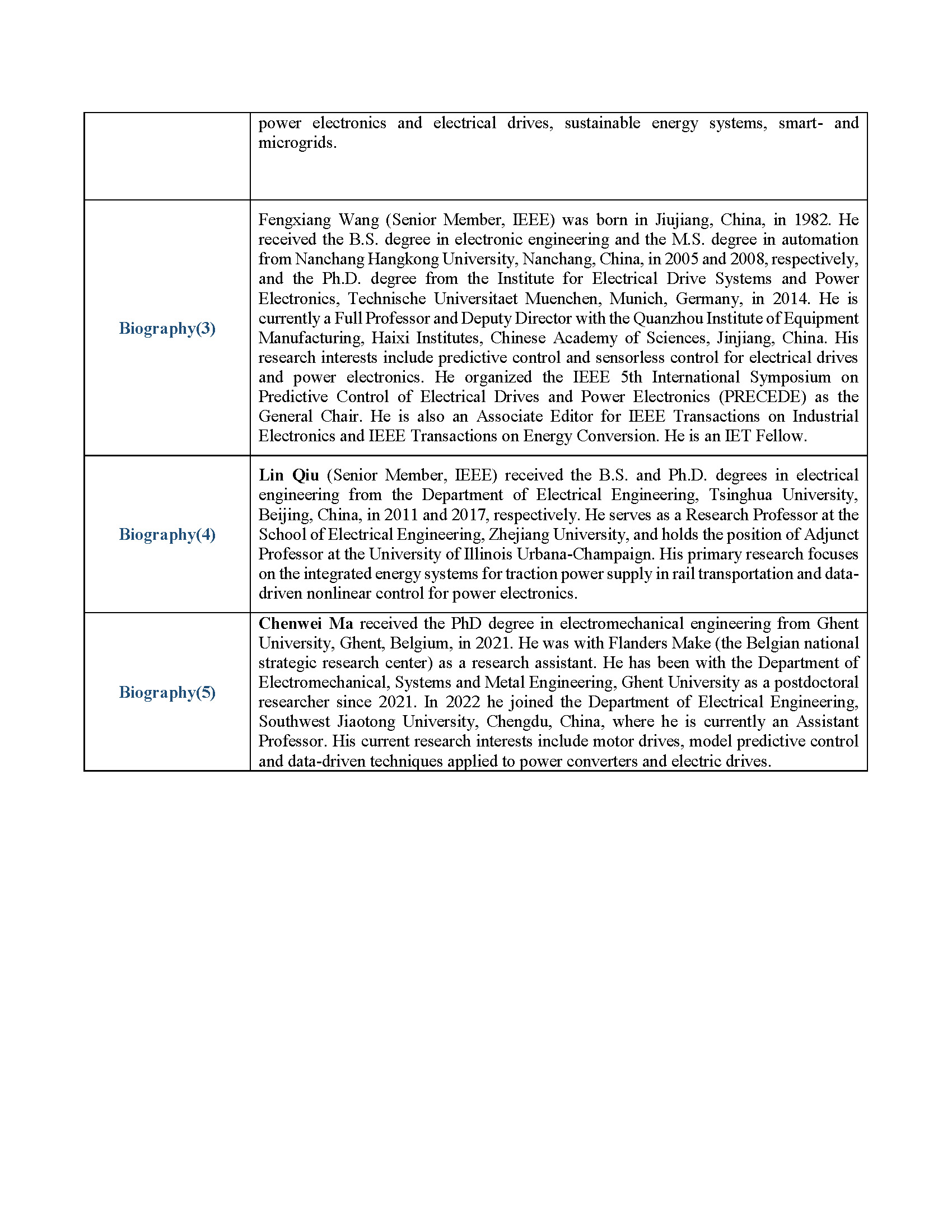
3.
Design, Analysis, and Control of Advanced Electric Machines

|
Name |
Chunhua Liu |
|
|
|
Title |
Professor |
||
|
Affiliation |
City University of Hong Kong |
||
|
|
chunliu@cityu.edu.hk |
||
|
Tutorial title |
Design, Analysis, and Control of Advanced Electric Machines |
||
|
Abstract |
Electric machines are welcomed for electrified propulsion systems, such as electric vehicles, electric aircraft, electric ships, electric robotics, etc. Also, they are popularly used for renewable energy generation, such as wind power generation, water power generation, etc. This tutorial will explore the latest advancements of electric machines in magnet materials, geometries, and configurations, aiming to achieve higher power density and efficiency. Through case studies and practical examples, it will showcase innovative design techniques that enable the development of advanced electric machines. Moreover, the tutorial will focus on advanced modeling and analysis methods for electric machines. it will cover various analytical modeling approaches, optimization techniques, and multiphysics analysis tools. Attendees will gain insights into how to accurately simulate and predict the performance of electric machines, allowing for informed design decisions and performance improvements. In addition, the tutorial will introduce the application of different control strategies to advanced motor drive control systems, such as sensorless control, fault-tolerant control, model predictive control, etc. The control framework aims to achieve the unique dynamic performances and advantages in different applications. |
||
|
Key words |
Electric machines, Permanent magnet machines, Motor control, Analytical model, Predictive control |
||
|
Biography |
Prof. Chunhua Liu is Professor in electrical and electronic engineering at the School of Energy and Environment with City University of Hong Kong, Hong Kong SAR. His research interests include electric machines and drives, electric vehicles and aircraft, electric robotics and ships, renewables and microgrids, power electronics and wireless power transfer. In these areas, he has published over 300 refereed papers. In addition, he is an RGC Research Fellow, Distinguished Lecturer of IEEE Vehicular Technology Society (VTS), and World's Top 2% Scientists according to metrics compiled by Stanford University. Also, he is Chair & Founder of both Hong Kong Chapter, IEEE Vehicular Technology Society, and Hong Kong & Guangzhou Joint Chapter, IEEE Industrial Electronics Society, respectively. Prof. Liu is now an Associate Editor of IEEE Transactions on Industrial Electronics, Editor of IEEE Transactions on Vehicular Technology, Editor of IEEE Transactions on Energy Conversion, and Editor of IEEE Power Engineering Letters. Also, he is an Editor of Energies, Subject Editor of IET – Renewable Power Generation, Associate Editor of Open Journal of the Industrial Electronics Society, Assocate Editor of IEEE Access; Associate Editor of IEEE Chinese Journal of Electrical Engineering, Associate Editor of CES Transactions on Electrical Machines and Systems, Associate Editor of Elsevier Green Energy and Intelligent Transportation, and Editor of IEEE Transactions on Magnetics – Conference, respectively. |
||
4.
High-Power Converters for Power-to-X Applications

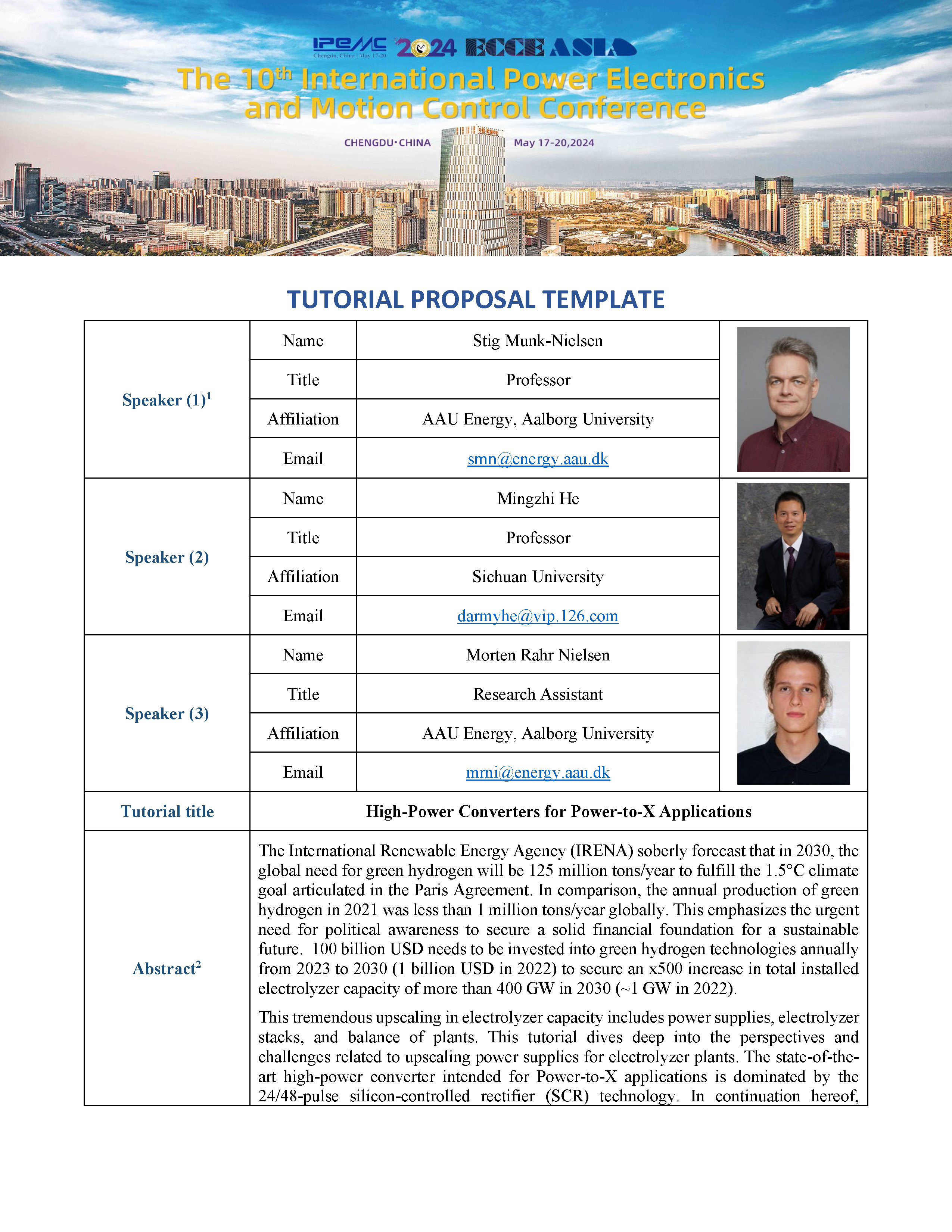

5.
Stability and Control of Grid-Forming Converters

|
Spesker(1) |
Name |
Xiongfei Wang |
|
|
Title |
Professor |
||
|
Affiliation |
KTH Royal Institute of Technology |
||
|
|
xiongfei@kth.se |
||
|
Speaker(2) |
Name |
Heng Wu |
|
|
Title |
Assistant Professor |
||
|
Affiliation |
Aalborg University |
||
|
|
|||
|
Abstract |
The grid-forming (GFM) technology is emerging as a promising approach for massive integration of inverter-based resources (IBRs) into electrical grids. Being controlled as a voltage source behind an impedance, GFM-IBRs can provide adequate services to enhance the reliability and resilience of the power network, and they also feature higher stability robustness against grid strength variation than conventional IBRs. In recent years, there is a growing consensus on the need of GFM-IBRs in the future power electronic dominated power systems. Many research and development (R&D) efforts have been initiated, by governments, power system operators, energy developers, and vendors of IBRS, on the technical specifications/grid codes, hardware and control solutions for GFM-IBRs. This tutorial intends to cover both the basics and advances in GFM-IBRs that can fit the requirements of the evolving technical specifications/grid codes. The tutorial will start with the basic principles and typical control architectures of GFM-IBRs, which will be followed by the small-signal modeling, stability analysis, and damping control to guarantee the small-signal stability of GFM-IBRs considering different DC-link dynamics under various grid strengths. Then, the dynamics analysis of GFM-IBRs under large grid disturbances, e.g., grid faults and phase jumps, will be performed, covering the transient stability analysis, current limitation strategies, as well as GFM service provisions. In the end, perspectives on the prospects and challenges with the grid integration of GFM-IBRs will be shared. |
||
|
Key words |
Inverter-based resources, grid-forming, stability |
||
|
Biography(1) |
Xiongfei Wang is a Professor at KTH Royal Institute of Technology, Sweden, and a part-time Professor with AAU Energy, Aalborg University, Denmark. He has been active tutorial instructors (e.g., PEDG, APEC, ECCE, EPE, eGrid) on stability and control of inverter-based resources and power systems. Dr. Wang is an IEEE Fellow and the recipient of the Richard M. Bass Outstanding Young Power Electronics Engineer Award, the IEEE PELS Sustainable Energy Systems Technical Achievement Award, the Isao Takahashi Power Electronics Award, and of the Clarivate Highly Cited Researcher during 2019-2021. |
||
|
Biography(2) |
Heng Wu is currently an Assistant Professor with AAU Energy, Aalborg University, Denmark. His research interests include the modelling and stability analysis of the power electronic based power systems. He is the Chairman of IEEE Task Force on Frequency-domain Modeling and Dynamic Analysis of HVDC and FACTS, the subgroup leader of CIGRE working group B4/C4.93 “Development of grid forming converters for secure and reliable operation of future electricity systems”, and the member of GB grid forming best practice expert group formed by national grid ESO, U.K. He is identified as world’s top 2% scientist by Stanford University from 2019. |
||
6.
SiC MOSFET Gate Drivers for High-Power Applications

|
Speaker (1) |
Name |
Drazen Dujic |
|
|
Title |
Associate Professor |
||
|
Affiliation |
EPFL, Switzerland |
||
|
|
|||
|
Speaker (2) |
Name |
Chengmin Li |
|
|
Title |
Assistant Professor |
||
|
Affiliation |
TU/e, Netherlands |
||
|
|
c.li7@tue.nl |
||
|
Abstract |
As the next-generation power devices, SiC MOSFETs are gradually increasing their presence in a wide range of applications. Compared with the silicon counterparts, SiC MOSFET has higher voltage blocking capability, high switching frequency and potential high-temperature capability. These superior characteristics will significantly improve the performance of power conversion systems where efficiency and power density are the most critical performances. As the link between the control and power in the power electronics system, gate driving of SiC MOSFETs is critical to fully utilize the potential of the devices. However, simply leveraging solutions for Si devices are not enough. The challenges brought by high-speed switching, reliability-related issues and cost constraints require continuous work. This tutorial covers the basics of the SiC devices, the ultra high-speed switching characteristics, the gate driving principles and device protections, as well as the high power applications of SiC MOSFETs. This will be supported by practical examples and learnings of the authors from Power Electronics Laboratories at EPFL, Switzerland and TU/e, Netherlands- |
||
|
Key words |
Power semiconductors, SIC, MOSFET, Gate driver, protection |
||
|
Biography(1) |
Prof. Drazen Dujic is an Associate Professor and Head of the Power Electronics Laboratory at EPFL in Lausanne, Switzerland. He received his PhD degree from Liverpool John Moores University in 2008. From 2009 to 2013 he was with ABB Switzerland and has joined EPFL in 2014. His research interests include the areas of design and control of advanced high-power electronic systems and high-performance drives, predominantly for the medium voltage applications related to electrical energy generation, conversion and storage. |
||
|
Biography(2) |
Prof. Chengmin Li is an Assistant Professor at TU/e in Eindhoven, Netherlands. He was a Postdoctoral researcher at Power Electronics Laboratory at EPFL in Lausanne, Switzerland from 2020 to 2023. He received the Ph.D. degree from Zhejiang University, Hangzhou, China in 2019. From March 2016 to March 2017, he was a Research Intern with the GE Global Research Center, Shanghai, China. His research interests are related to medium voltage high converters and application of SiC power MOSFETs. Dr. Li was the recipient of PCIM Asia Young Engineer Award in 2022. |
||
7.
Modelling and Control of Wireless Power Transfer: State of the Art

|
Speaker(1) |
Name |
Minfan Fu |
|
|
Title |
Associate Professor |
||
|
Affiliation |
ShanghaiTech University |
||
|
|
fumf@shanghaitech.edu.cn |
||
|
Speaker(2) |
Name |
Yun Yang |
|
|
Title |
Assistant Professor |
||
|
Affiliation |
Nanyang Technological University |
||
|
|
yun.yang@ntu.edu.sg |
||
|
Speaker(3) |
Name |
Yong Li |
|
|
Title |
Associate Professor |
||
|
Affiliation |
Southwest Jiaotong University |
||
|
|
Yong_Li@swjtu.edu.cn |
||
|
Abstract |
In recent times, there has been a resurgence of interest in wireless power transfer (WPT), driven by the pressing need to wirelessly charge a multitude of consumer electronic devices such as smartphones, laptops, tablets, medical implants, and various peripherals. End users aspire to sever the final physical connection, the electrical charging wire, so that, for the first time, both information and power can be accessed ubiquitously through the air. WPT not only streamlines and secures the daily charging routine, but it also paves the way for a new paradigm in power management. This tutorial will commence with an overview of the fundamental aspects of wireless power transfer systems, highlighting the advantages and trade-offs associated with different solutions. It will delve into a comprehensive examination of two fundamental near-field coupling methods: magnetic field coupling and electrical field coupling, offering a unified perspective. This presentation aims to convey the core concepts starting from a foundational level, encompassing the coupler structure, coupler model, compensation networks and their design objectives, inverters and rectifiers, modulation, hybrid compensation, converter model, and dynamic control. Additionally, a brief review of the current state-of-the-art and potential challenges in WPT will be provided. |
||
|
Biography(1) |
Minfan Fu received the B.S., M.S., and Ph.D. degrees in electrical and computer engineering from University of Michigan-Shanghai JiaoTong University Joint Institute, Shanghai Jiao Tong University, Shanghai, China in 2010, 2013, and 2016. He is currently a tenured Associate Professor at School of Information Science and Technology (SIST). |
||
|
Biography(2) |
Yun Yang received his Ph.D. degree in Electrical Engineering from The University of Hong Kong in 2017. He was a Research Assistant Professor in the Department of Electrical Engineering, the Hong Kong Polytechnic University from 2020 to 2022, and an Honorary Research Assistant Professor in the Department of Electrical and Electronic Engineering, the University of Hong Kong. |
||
|
Biography(3) |
Yong Li, Associate Professor with Southwest Jiaotong University, received the B.Sc. and Ph.D. degrees from the School of Electrical Engineering, Southwest Jiaotong University, Chengdu, China, in 2013 and 2017, respectively. From 2017 to 2018, he was a Research Associate at the Department of Electrical Engineering, The Hong Kong Polytechnic University, and subsequently, he was a Post-Doctoral Fellow with the same department. |
||
8.
Design and Control of Solid-State DC Transformers for DC Transmission and Distribution Grids

|
Speaker(1) |
Name |
Rik W. De Doncker |
|
|
Title |
Professor |
||
|
Affiliation |
RWTH Aachen University |
||
|
|
dedoncker@eonerc.rwth-aachen.de |
||
|
Speaker(2) |
Name |
Jingxin Hu |
|
|
Title |
Professor |
||
|
Affiliation |
Nanjing University of Aeronautics and Astronautics |
||
|
|
jingxin.hu@nuaa.edu.cn |
||
|
Speaker(3) |
Name |
Shenghui Cui |
|
|
Title |
Assistant Professor |
||
|
Affiliation |
Seoul National University |
||
|
|
cuish@snu.ac.kr |
||
|
Speaker(4) |
Name |
Subhashish Bhattacharya |
|
|
Title |
Professor |
||
|
Affiliation |
North Carolina State University |
||
|
|
sbhatta4@ncsu.edu |
||
|
Tutorial title |
Design and Control of Solid-State DC Transformers for DC Transmission and Distribution Grids |
||
|
Abstract |
The transition from a predominantly fossil fuel-based power generation towards renewable power sources, predominantly wind turbines and photovoltaic systems, inevitably leads towards an energy supply system that greatly depends on power electronics to feed the energy in the electrical grid. As all power electronic driven systems are intrinsically DC sources or loads, DC transmission and distribution systems become evident, not only because it is more efficient and cost effective, but also increases the ampacity of cables. The development and commercialization of medium-voltage, multi-megawatt DC-DC converters, also called solid-state DC transformers, is a key enabler to realize flexible and interconnected DC grids. Compared to AC transformers, solid-state DC transformers not only need to transform voltage and control power flow, but also need to offer similar efficiencies (up to 99%) at high switching frequencies, provide the same insulation levels and limit fault currents, that is, offer fault-ride-through capabilities. In this tutorial, we introduce and describe the latest advances and best practices of galvanically isolated bidirectional DC-DC converters for solid-state DC transformers. It covers a wide selection of key enabling technologies from converter topologies, optimized control, to the design of highly efficient megawatt medium-voltage DC-DC converters based on emerging MV SiC devices. |
||

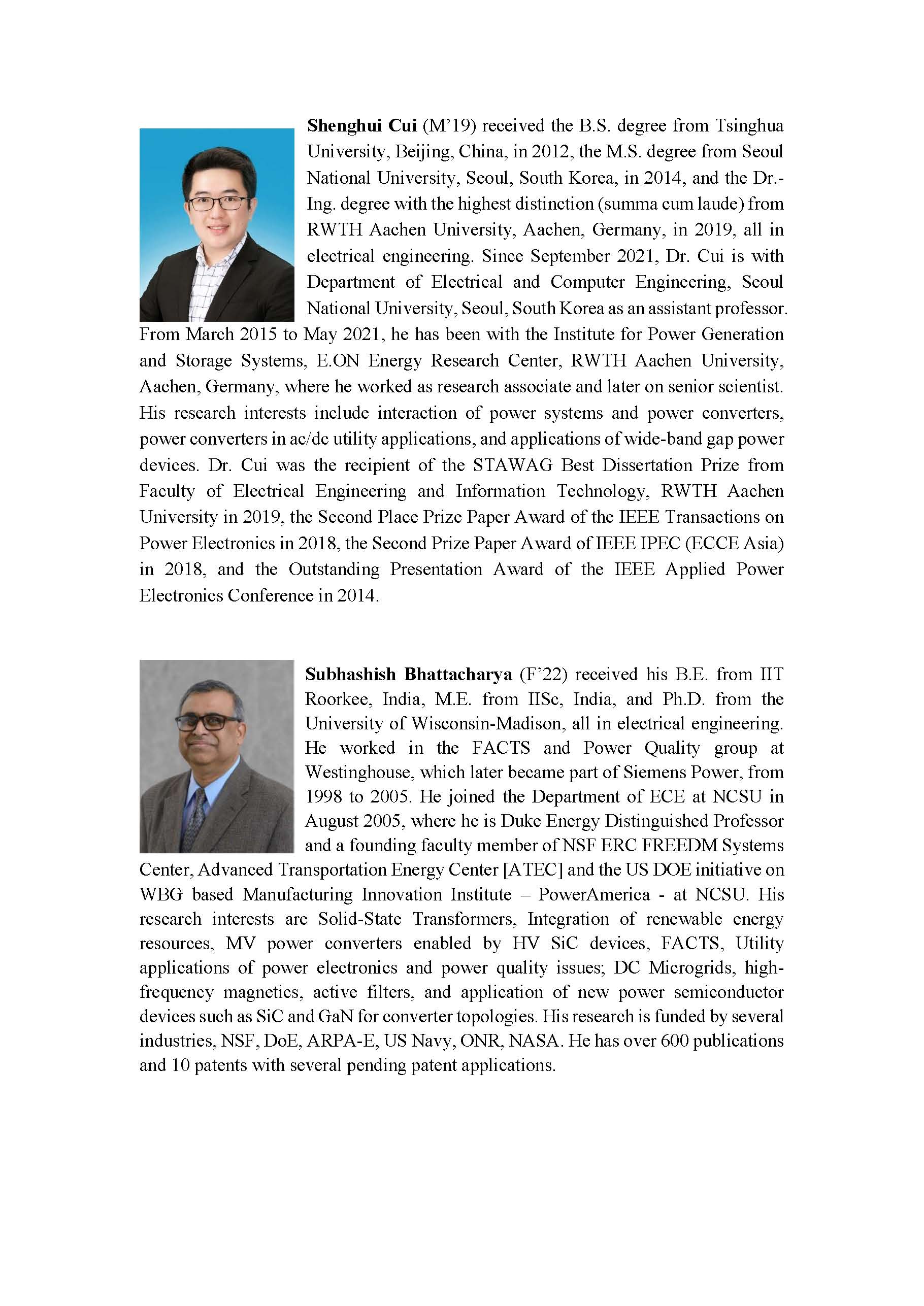
9.
Fault Diagnosis and Tolerant Control of AC Motor Drives

|
Name |
Zheng Wang |
|
|
|
Title |
Professor |
||
|
Affiliation |
Southeast University, China |
||
|
|
zwang@seu.edu.cn |
||
|
Speaker(2) |
Name |
Jiangbiao He |
|
|
Title |
Associate Professor |
||
|
Affiliation |
University of Kentucky, USA |
||
|
|
jiangbiao@ieee.org |
||
|
Speaker(3) |
Name |
Xueqing Wang |
|
|
Title |
Associate Professor |
||
|
Affiliation |
Sichuan University, China |
||
|
|
xwang@scu.edu.cn |
||
|
Abstract |
Nowadays, AC motor drives have been intensively used in more and more emerging applications. Especially, the rapid development of transportation electrification promotes the further development of AC motor drives to a new level. Reliability has become a key technical index of the new-generation AC motor drives for safety-critical applications. Power electronic devices and winding insulation are two vulnerable components in AC motor-drive systems due to aging, overloading, and abnormal operations. If the faults that occurred in the AC motor drives are intervened timely, they may result in catastrophic damages to the overall system through fault propagation. Fault diagnosis, and fault-tolerant control play important roles to improve the reliability of AC motor drives. Fault diagnosis technique functions to locate the fault accurately and rapidly by extracting fault features from sensors. Fault-tolerant control techniques enable the continuous operation of AC motor drives after occurrence of faults. This tutorial will present the techniques of fault diagnosis and fault-tolerant control of AC motor drives, including the standard AC motor drives, multilevel AC motor drives, and multiphase AC motor drives. |
||
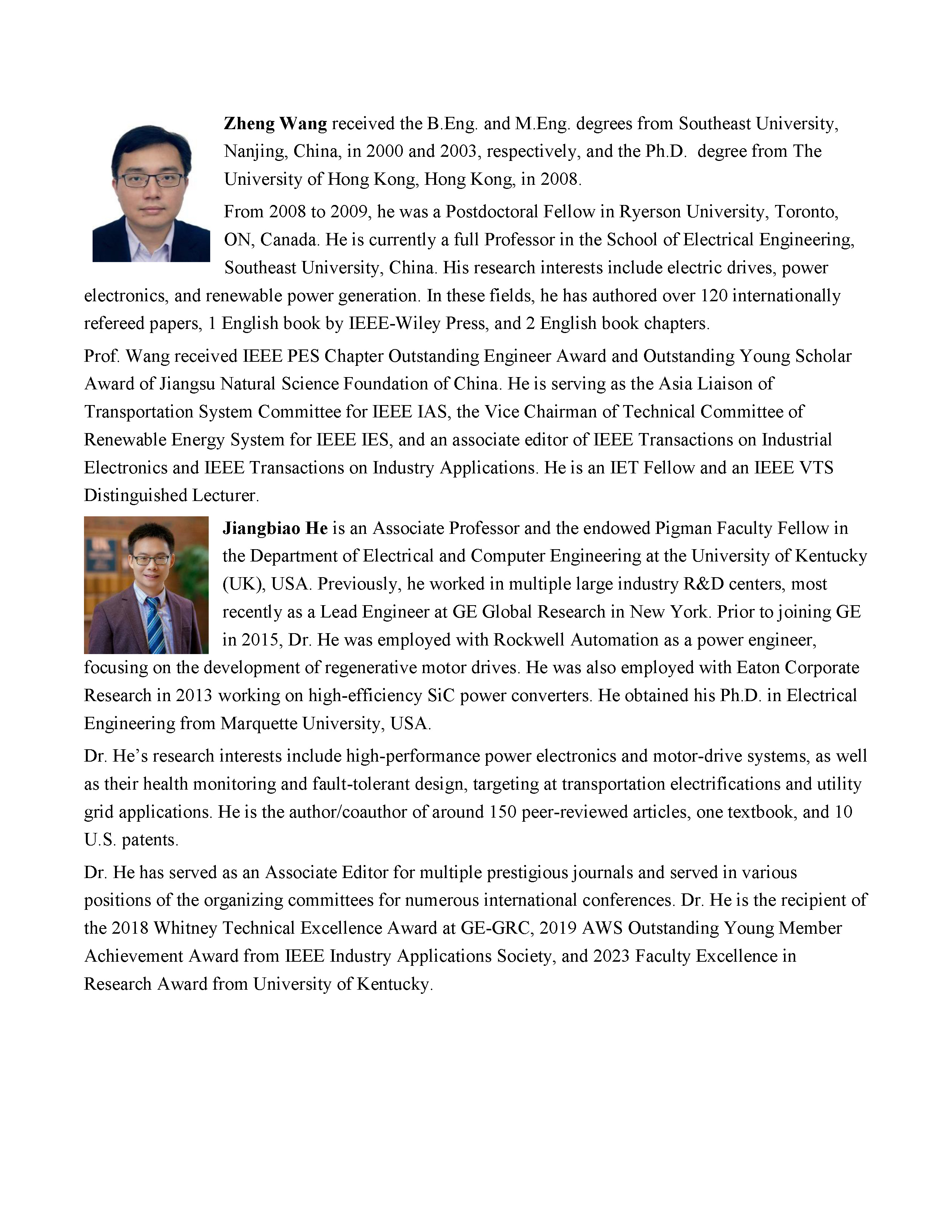
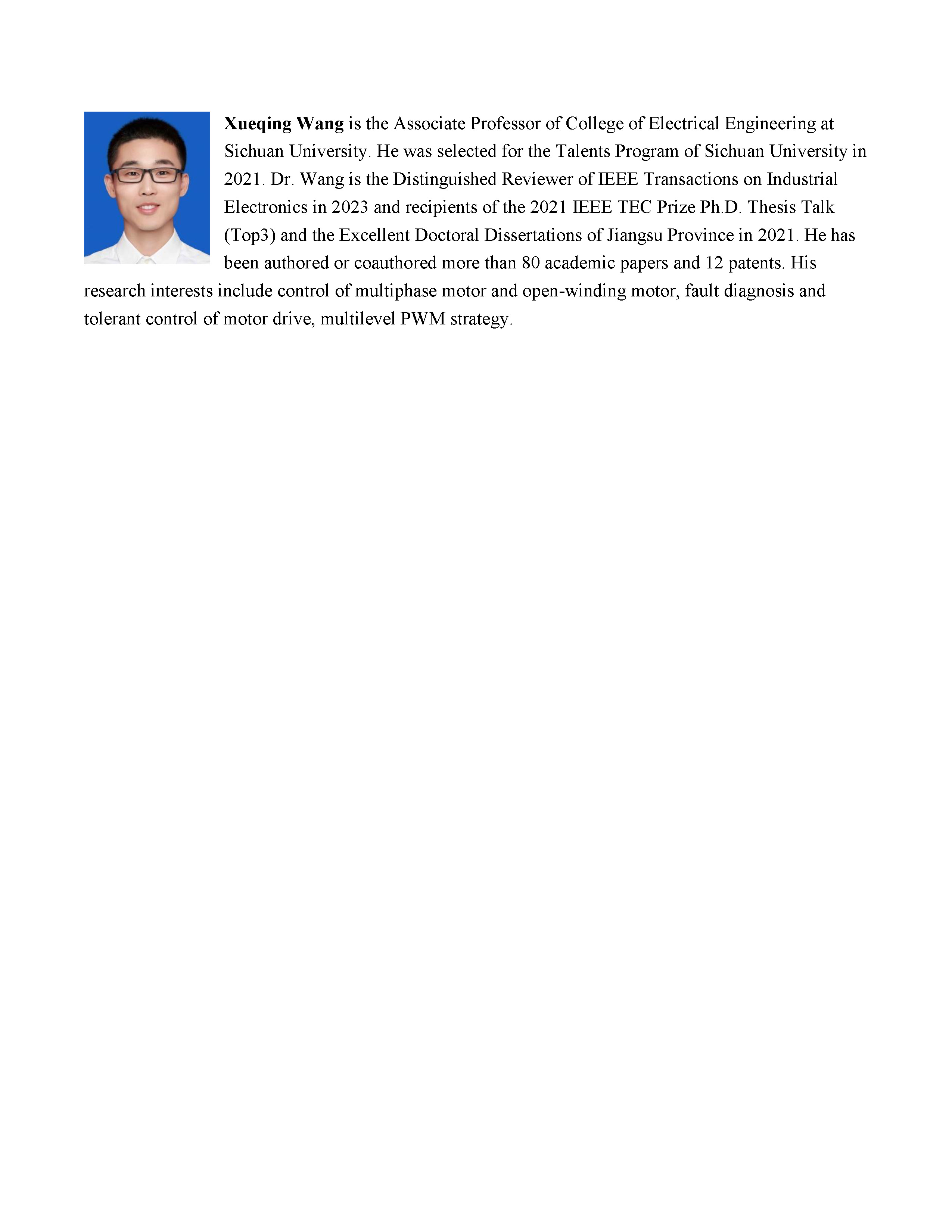
10.
Power Electronics as the Enabling Technology for Buildings Decarbonization

|
Speaker(1) |
Name |
Dmitri Vinnikov |
|
|
Title |
Research Professor |
||
|
Affiliation |
Tallinn University of Technology |
||
|
|
dmitri.vinnikov@taltech.ee |
||
|
Speaker(2) |
Name |
Andrii Chub |
|
|
Title |
Senior Researcher |
||
|
Affiliation |
Tallinn University of Technology |
||
|
|
andrii.chub@taltech.ee |
||
|
Speaker(3) |
Name |
Andrei Blinov |
|
|
Title |
Senior Researcher |
||
|
Affiliation |
Tallinn University of Technology |
||
|
|
andrei.blinov@taltech.ee |
||
|
Abstract |
As the world combats climate change, the decarbonization of buildings stands out as a pivotal goal. Buildings significantly contribute to greenhouse gas emissions, largely due to their energy consumption. Nowadays, energy performance labels are assigned to existing and newly commissioned buildings. Moreover, some countries forbade commissioning new buildings with labels below “A.” Achieving sustainability in the built environment necessitates innovative solutions that can dramatically reduce carbon footprints. The existing technologies based on AC distribution have reached maturity, and new approaches are required to enhance the energy efficiency of buildings further. The combination of power electronics and DC microgrids has emerged as a transformative technology in this endeavor. To accelerate the transition to decarbonized buildings, it is essential to foster innovation, invest in research and development, and promote policies that encourage the adoption of power electronics and DC microgrid solutions. They can further optimize energy usage, integrate renewable energy sources, and create highly efficient and sustainable building ecosystems. DC buildings feature enhanced resilience, for example, in the face of grid failures or disasters. DC microgrids with power electronics can operate autonomously, providing critical power to essential systems like lighting, communication, and HVAC, independently from the AC-grid. This makes power electronics and DC microgrids indispensable tools for building stock decarbonization. Their combined use not only reduces carbon emissions but also improves energy sustainability and grid independence of buildings. This tutorial will explore the essence of residential DC distribution technology and provide an insight into recent development trends, standardization, and challenges. It will demonstrate a set of emerging power electronic technologies for the in-house energy generation, distribution, storage, and management of DC buildings as well as their interaction with AC-grid. |
||
|
Key words |
Electrification, energy efficient buildings, power electronics systems, dc microgrids, grid-interactive buildings |
||

